Officials Continue to Allow Vegetation Clearing During the Nesting Season of Birds Protected Under Federal Law
Last week, ForestWatch warned the U.S. Forest Service that a vegetation clearing project in the Los Padres National Forest runs afoul of state and federal laws designed to protect bird nests and young birds during the nesting season.
The warning – hand-delivered to forest headquarters on March 15 – came after the Forest Service repeatedly ignored ForestWatch requests to avoid clearing native chaparral during the bird nesting season for several species of birds that receive “high priority” for protection under the federal Migratory Bird Treaty Act (“MBTA”).
Under the MBTA, it is unlawful to destroy nests or eggs of any migratory bird species without a permit. Several provisions of the California Fish & Game Code also prohibit the destruction of bird nests. Because of these laws, agencies and landowners typically avoid clearing native vegetation from February through August when most migratory bird species are building their nests and raising their young. For example, the County of Santa Barbara and several local fire agencies routinely avoid clearing vegetation between February 1 and August 30. The California Department of Fish & Game generally recommends a February through August avoidance period. And the recently-completed Community Wildfire Protection Plan for Mission Canyon cites a “February through August” avoidance period as well.
But the Forest Service has steadfastly refused to adopt this February through August timeframe. Instead, forest officials contend that birds only nest in the project area from May 1 to July 10 – just three months instead of the usual seven months that local bird experts overwhelmingly recommend.
“It remains unclear why the Forest Service thinks it can ignore a law that every other state and federal agency firmly embraces,” said Jeff Kuyper, executive director of Los Padres ForestWatch. “We find it unnecessary and unacceptable to mow down bird nests and young songbirds during the nesting season. The Forest Service has a responsibility to protect our nation’s migratory birds and we are giving them one last opportunity to do the right thing.”
The vegetation clearing is part of a massive fuelbreak project approved by the Forest Service in 2002. Using a giant lawnmower-like machine called a “masticator,” the project calls for a 40-mile long, 300 foot-wide fuelbreak along the crest of the Santa Ynez Mountain from Refugio Pass to Romero Saddle. The project was approved without any environmental assessment, with the Forest Service claiming that the project was “wildlife habitat improvement” and thus exempt from environmental review.
Work under this project began in 2006 along East Camino Cielo, and after a year-long break, work resumed along the more remote portions of West Camino Cielo. The work is funded with economic stimulus dollars, but the contract was awarded to an out-of-state corporation based in Idaho.
At least eight “high priority” bird species build nests in the project area, including common poorwill, blue-gray gnatcatcher, California thrasher, rufous-crowned sparrow, black-chinned sparrow, sage sparrow, Lazuli bunting, and Lawrence’s goldfinch. And at least fourteen additional types of birds in the project area receive protection under the MBTA.
Migratory birds are perhaps the most highly valued component of North America’s biological diversity, with approximately 1,200 species representing nearly 15% of the world’s known bird species. The seasonal movement of migratory birds is one of the most complex and compelling dramas in the natural world. Migratory birds embark twice each year on long-distance journeys between their breeding areas and their wintering grounds, which are sometimes separated by thousands of miles. State, federal, and international law all recognize the importance of protecting migratory bird species from harm.
Requests Repeatedly Denied
The Forest Service has been on notice about the proper bird nesting season since at least 2009, when ForestWatch and several other local environmental organizations wrote a letter to Forest Supervisor Peggy Hernandez. ForestWatch repeated this warning in a February 2011 letter urging the Forest Service to prohibit any vegetation clearing from February through August. Face-to-face meetings with forest officials in January and March 2012 proved equally fruitless, with the Forest Service continuing to steadfastly deny our requests.
On March 15, instead of going directly to court, ForestWatch delivered a Notice of Intent to Sue the Forest Service, outlining in detail the requirements of the MBTA and demanding that the Forest Service comply with state and federal bird protection laws. Clearing has not occurred since then and it is unclear when it will resume. In the meantime, ForestWatch continues to monitor the project site, visiting the area several times per week.
Forest Service Response: Fear-Mongering & Scare Tactics
 Instead of working with ForestWatch to address our concerns, this week the Forest Service placed backdoor calls to media outlets and local residents, fanning the flames of our community’s fears about wildfire. In an article in the Santa Barbara Independent, the forest’s PIO Andrew Madsen is quoted as saying, “This is part of our ongoing relationship with ForestWatch. Does this make you feel more safe? I know if I owned a home up in Mission Canyon, I might want to have some input on this. This potentially has a great impact on a number of folks who live and work in these areas.”
Instead of working with ForestWatch to address our concerns, this week the Forest Service placed backdoor calls to media outlets and local residents, fanning the flames of our community’s fears about wildfire. In an article in the Santa Barbara Independent, the forest’s PIO Andrew Madsen is quoted as saying, “This is part of our ongoing relationship with ForestWatch. Does this make you feel more safe? I know if I owned a home up in Mission Canyon, I might want to have some input on this. This potentially has a great impact on a number of folks who live and work in these areas.”
Fear-mongering and poor form aside, Mr. Madsen’s reference to Mission Canyon is an interesting one. Residents of Mission Canyon produced a Community Wildfire Protection Plan last year, in conjunction with County Fire and CalFire. Even that plan cites a “February through August” avoidance period for vegetation clearing to protect nesting birds, leaving many to wonder why the Forest Service can’t just get with the program that everyone else tuned into years ago.
Rare Plants Destroyed
The project area contains four plant species that the Forest Service has classified as “Sensitive” due to their limited range. In fact, two of the plants – Refugio manzanita and Santa Ynez false-lupine – are only found along this ridge and nowhere else in the world. To protect these plants, the Forest Service in 2010 agreed to survey the areas to be cleared, to flag any rare plants for avoidance, and to leave a ten-foot buffer around each plant.
On recent visits to the project site, we found rare plants that had been flagged for avoidance, but vegetation was mowed right up to the base of the rare plants without the required ten-foot buffer. In some cases, all we found were chewed-up flags on the ground, tied to chopped-up fragments of rare plants that appeared to have been completely mowed down. It is unknown how many rare plants were destroyed, but ForestWatch continues to visit the project site and gather evidence of this wrongdoing.
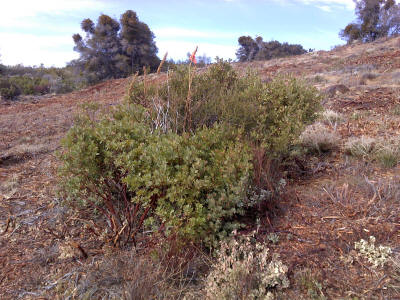
Chaparral was cleared up to two feet from this rare plant. The Forest Service’s own botanist recommended a minimum ten-foot buffer around all rare plants to protect them from invasive weeds that grow in cleared areas.

During an inspection of a recently-cleared area, ForestWatch discovered this remnant of a Santa Ynez false-lupine bush. The flag indicates that this bush was supposed to be protected from clearing. We never found the bush, just this fragment of a flower stalk with a flag tied to it, suggesting that the plant was destroyed.
Toxic Chemicals Spilled
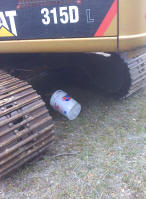 Also on recent visits, ForestWatch discovered a plastic five-gallon bucket placed under the masticator to catch drops of a black, oily fluid dripping from the underside of the machine. A recent storm with strong winds had tipped the bucket on its side, spilling the toxic brew onto the forest floor. With the bucket on its side, the masticator continued to drip additional fluid onto the forest floor.
Also on recent visits, ForestWatch discovered a plastic five-gallon bucket placed under the masticator to catch drops of a black, oily fluid dripping from the underside of the machine. A recent storm with strong winds had tipped the bucket on its side, spilling the toxic brew onto the forest floor. With the bucket on its side, the masticator continued to drip additional fluid onto the forest floor.
The contract issued by the Forest Service requires the contractor to prevent oil leaks, to properly dispose of hazardous waste, and to remove trash daily. ForestWatch has notified the Forest Service about this toxic spill and is awaiting a response from the agency.
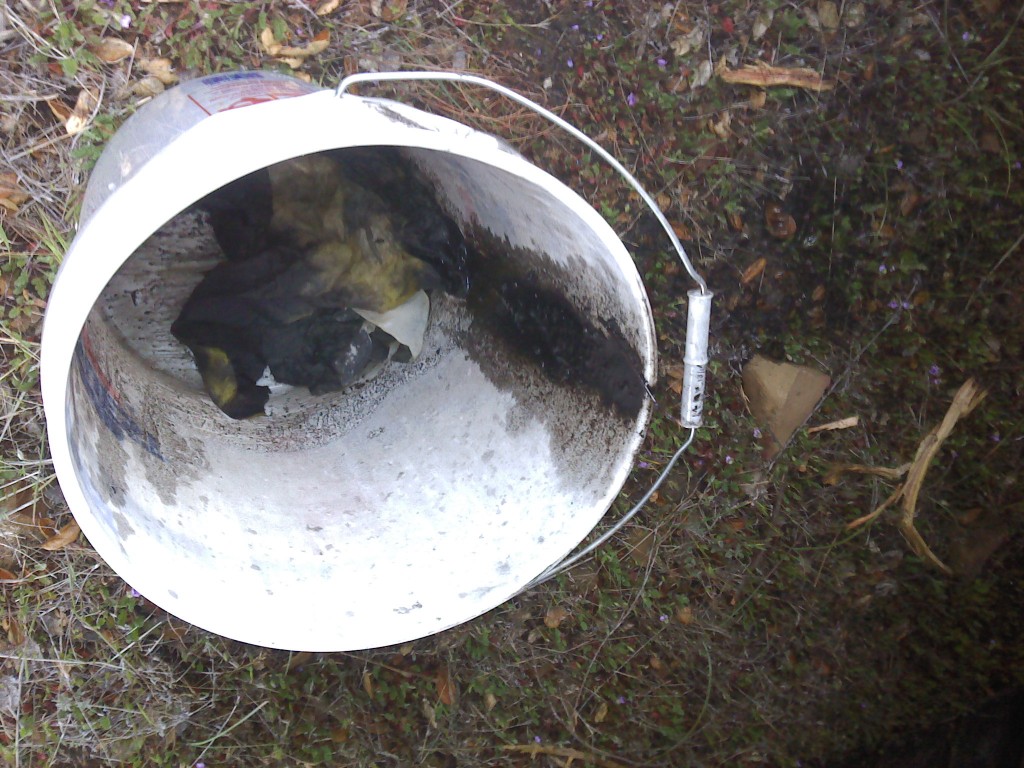
Oily towels and residue are all that remain of potentially toxic material that was spilled on national forest land. ForestWatch returned the bucket to its upright position to capture fluid that continued to leak from the masticator, and notified the Forest Service.
Off-Road Vehicles Run Rampant
West Camino Cielo has an extensive network of illegal off-road vehicle trails, carved over time through the landscape when dirtbikes, ATVs, and four-wheel drive vehicles repeatedly drive through an undisturbed area. These renegade off-roaders particularly like areas that have been cleared of vegetation, and the Forest Service has spent hundreds of thousand of dollars along West Camino Cielo to place barriers along these cleared areas to keep vehicles on the roads.
When the Forest Service approved this project in 2002, the agency pledged to maintain or expand existing roadside barriers, and to evaluate and create new barriers. However, on a recent visit to the area, ForestWatch found newly-placed boulders removed, and new vehicle tracks cutting through a recently-masticated area. ForestWatch has submitted this information to the Forest Service and is awaiting an official response.
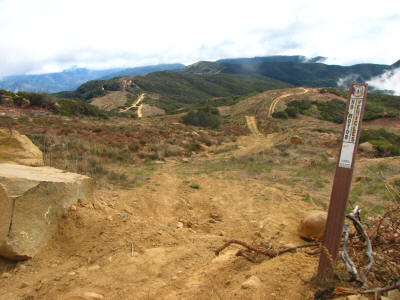
March 2012 photo showing the remnants of efforts to prevent illegal motorized trespass in a recently-mowed area. Several boulders blocking access to this area were pulled into the roadway, allowing dirtbikes, ATVs and four-wheel vehicles to illegally access this area, promoting the spread of invasive weeds and increases the fire danger to surrounding communities.
Next Steps
ForestWatch will continue to frequently monitor the area to ensure that work does not commence during the bird nesting season. In a recent letter to the Forest Service, ForestWatch also offered to begin discussions with the agency about how to better plan for bird nesting seasons in vegetation clearing projects. Our hope is that the Forest Service will better acknowledge the important role that migratory songbirds play in ensuring healthy, intact ecosystems, and will take steps in the future to better protect their habitat, their nests, and young birds. Given the Forest Service’s recent behavior and comments to the media, however, it is unknown how seriously the agency takes its responsibility to comply with the law and protect bird nests and young songbirds.

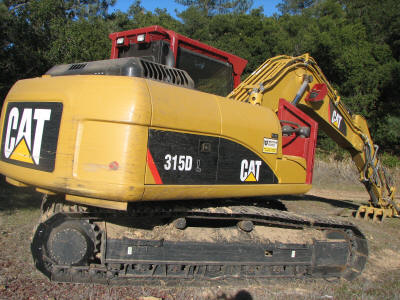
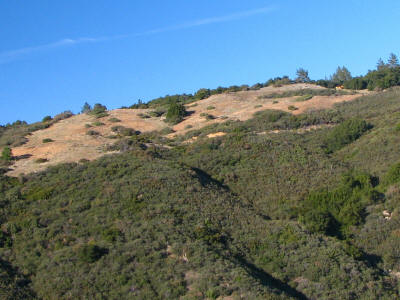






Comments are closed.